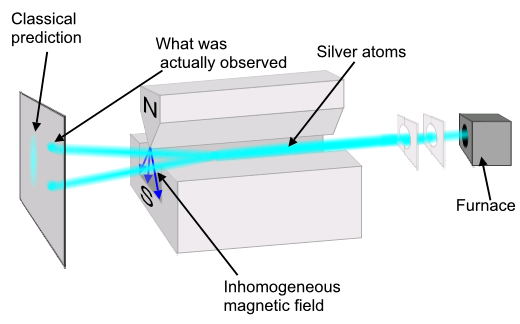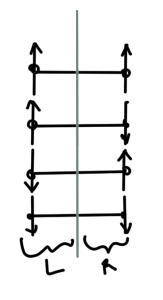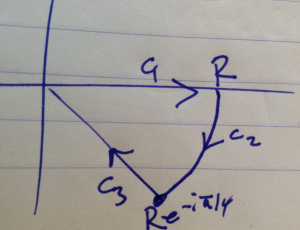
[Click here for a PDF of this post with nicer formatting]
Question: Operator matrix representation ([1] pr. 1.5)
(a)
Determine the matrix representation of \( \ket{\alpha}\bra{\beta} \) given a complete set of eigenvectors \( \ket{a^r} \).
(b)
Verify with \( \ket{\alpha} = \ket{s_z = \Hbar/2}, \ket{s_x = \Hbar/2} \).
Answer
(a)
Forming the matrix element
\begin{equation}\label{eqn:moreBraKetProblems:20}
\begin{aligned}
\bra{a^r} \lr{ \ket{\alpha}\bra{\beta} } \ket{a^s}
&=
\braket{a^r}{\alpha}\braket{\beta}{a^s} \\
&=
\braket{a^r}{\alpha}
\braket{a^s}{\beta}^\conj,
\end{aligned}
\end{equation}
the matrix representation is seen to be
\begin{equation}\label{eqn:moreBraKetProblems:40}
\ket{\alpha}\bra{\beta}
\sim
\begin{bmatrix}
\bra{a^1} \lr{ \ket{\alpha}\bra{\beta} } \ket{a^1} & \bra{a^1} \lr{ \ket{\alpha}\bra{\beta} } \ket{a^2} & \cdots \\
\bra{a^2} \lr{ \ket{\alpha}\bra{\beta} } \ket{a^1} & \bra{a^2} \lr{ \ket{\alpha}\bra{\beta} } \ket{a^2} & \cdots \\
\vdots & \vdots & \ddots \\
\end{bmatrix}
=
\begin{bmatrix}
\braket{a^1}{\alpha} \braket{a^1}{\beta}^\conj & \braket{a^1}{\alpha} \braket{a^2}{\beta}^\conj & \cdots \\
\braket{a^2}{\alpha} \braket{a^1}{\beta}^\conj & \braket{a^2}{\alpha} \braket{a^2}{\beta}^\conj & \cdots \\
\vdots & \vdots & \ddots \\
\end{bmatrix}.
\end{equation}
(b)
First compute the spin-z representation of \( \ket{s_x = \Hbar/2 } \).
\begin{equation}\label{eqn:moreBraKetProblems:60}
\begin{aligned}
\lr{ S_x – \Hbar/2 I }
\begin{bmatrix}
a \\
b
\end{bmatrix}
&=
\lr{
\begin{bmatrix}
0 & \Hbar/2 \\
\Hbar/2 & 0 \\
\end{bmatrix}
–
\begin{bmatrix}
\Hbar/2 & 0 \\
0 & \Hbar/2 \\
\end{bmatrix}
} \\
&=
\begin{bmatrix}
a \\
b
\end{bmatrix} \\
&=
\frac{\Hbar}{2}
\begin{bmatrix}
-1 & 1 \\
1 & -1 \\
\end{bmatrix}
\begin{bmatrix}
a \\
b
\end{bmatrix},
\end{aligned}
\end{equation}
so \( \ket{s_x = \Hbar/2 } \propto (1,1) \).
Normalized we have
\begin{equation}\label{eqn:moreBraKetProblems:80}
\begin{aligned}
\ket{\alpha} &= \ket{s_z = \Hbar/2 } =
\begin{bmatrix}
1 \\
0
\end{bmatrix} \\
\ket{\beta} &= \ket{s_z = \Hbar/2 }
\inv{\sqrt{2}}
\begin{bmatrix}
1 \\
1
\end{bmatrix}.
\end{aligned}
\end{equation}
Using \ref{eqn:moreBraKetProblems:40} the matrix representation is
\begin{equation}\label{eqn:moreBraKetProblems:100}
\ket{\alpha}\bra{\beta}
\sim
\begin{bmatrix}
(1) (1/\sqrt{2})^\conj & (1) (1/\sqrt{2})^\conj \\
(0) (1/\sqrt{2})^\conj & (0) (1/\sqrt{2})^\conj \\
\end{bmatrix}
=
\inv{\sqrt{2}}
\begin{bmatrix}
1 & 1 \\
0 & 0
\end{bmatrix}.
\end{equation}
This can be confirmed with direct computation
\begin{equation}\label{eqn:moreBraKetProblems:120}
\begin{aligned}
\ket{\alpha}\bra{\beta}
&=
\begin{bmatrix}
1 \\
0
\end{bmatrix}
\inv{\sqrt{2}}
\begin{bmatrix}
1 & 1
\end{bmatrix} \\
&=
\inv{\sqrt{2}}
\begin{bmatrix}
1 & 1 \\
0 & 0
\end{bmatrix}.
\end{aligned}
\end{equation}
Question: eigenvalue of sum of kets ([1] pr. 1.6)
Given eigenkets \( \ket{i}, \ket{j} \) of an operator \( A \), what are the conditions that \( \ket{i} + \ket{j} \) is also an eigenvector?
Answer
Let \( A \ket{i} = i \ket{i}, A \ket{j} = j \ket{j} \), and suppose that the sum is an eigenket. Then there must be a value \( a \) such that
\begin{equation}\label{eqn:moreBraKetProblems:140}
A \lr{ \ket{i} + \ket{j} } = a \lr{ \ket{i} + \ket{j} },
\end{equation}
so
\begin{equation}\label{eqn:moreBraKetProblems:160}
i \ket{i} + j \ket{j} = a \lr{ \ket{i} + \ket{j} }.
\end{equation}
Operating with \( \bra{i}, \bra{j} \) respectively, gives
\begin{equation}\label{eqn:moreBraKetProblems:180}
\begin{aligned}
i &= a \\
j &= a,
\end{aligned}
\end{equation}
so for the sum to be an eigenket, both of the corresponding energy eigenvalues must be identical (i.e. linear combinations of degenerate eigenkets are also eigenkets).
Question: Null operator ([1] pr. 1.7)
Given eigenkets \( \ket{a’} \) of operator \( A \)
(a)
show that
\begin{equation}\label{eqn:moreBraKetProblems:200}
\prod_{a’} \lr{ A – a’ }
\end{equation}
is the null operator.
(b)
\begin{equation}\label{eqn:moreBraKetProblems:220}
\prod_{a” \ne a’} \frac{\lr{ A – a” }}{a’ – a”}
\end{equation}
(c)
Illustrate using \( S_z \) for a spin 1/2 system.
Answer
(a)
Application of \( \ket{a} \), the eigenket of \( A \) with eigenvalue \( a \) to any term \( A – a’ \) scales \( \ket{a} \) by \( a – a’ \), so the product operating on \( \ket{a} \) is
\begin{equation}\label{eqn:moreBraKetProblems:240}
\prod_{a’} \lr{ A – a’ } \ket{a} = \prod_{a’} \lr{ a – a’ } \ket{a}.
\end{equation}
Since \( \ket{a} \) is one of the \( \setlr{\ket{a’}} \) eigenkets of \( A \), one of these terms must be zero.
(b)
Again, consider the action of the operator on \( \ket{a} \),
\begin{equation}\label{eqn:moreBraKetProblems:260}
\prod_{a” \ne a’} \frac{\lr{ A – a” }}{a’ – a”} \ket{a}
=
\prod_{a” \ne a’} \frac{\lr{ a – a” }}{a’ – a”} \ket{a}.
\end{equation}
If \( \ket{a} = \ket{a’} \), then \( \prod_{a” \ne a’} \frac{\lr{ A – a” }}{a’ – a”} \ket{a} = \ket{a} \), whereas if it does not, then it equals one of the \( a” \) energy eigenvalues. This is a representation of the Kronecker delta function
\begin{equation}\label{eqn:moreBraKetProblems:300}
\prod_{a” \ne a’} \frac{\lr{ A – a” }}{a’ – a”} \ket{a} \equiv \delta_{a’, a} \ket{a}
\end{equation}
(c)
For operator \( S_z \) the eigenvalues are \( \setlr{ \Hbar/2, -\Hbar/2 } \), so the null operator must be
\begin{equation}\label{eqn:moreBraKetProblems:280}
\begin{aligned}
\prod_{a’} \lr{ A – a’ }
&=
\lr{ \frac{\Hbar}{2} }^2 \lr{ \begin{bmatrix} 1 & 0 \\ 0 & -1 \\ \end{bmatrix} – \begin{bmatrix} 1 & 0 \\ 0 & 1 \\ \end{bmatrix} } \lr{ \begin{bmatrix} 1 & 0 \\ 0 & -1 \\ \end{bmatrix} + \begin{bmatrix} 1 & 0 \\ 0 & 1 \\ \end{bmatrix} } \\
&=
\begin{bmatrix}
0 & 0 \\
0 & -2
\end{bmatrix}
\begin{bmatrix}
2 & 0 \\
0 & 0 \\
\end{bmatrix} \\
&=
\begin{bmatrix}
0 & 0 \\
0 & 0 \\
\end{bmatrix}
\end{aligned}
\end{equation}
For the delta representation, consider the \( \ket{\pm} \) states and their eigenvalue. The delta operators are
\begin{equation}\label{eqn:moreBraKetProblems:320}
\begin{aligned}
\prod_{a” \ne \Hbar/2} \frac{\lr{ A – a” }}{\Hbar/2 – a”}
&=
\frac{S_z – (-\Hbar/2) I}{\Hbar/2 – (-\Hbar/2)} \\
&=
\inv{2} \lr{ \sigma_z + I } \\
&=
\inv{2} \lr{ \begin{bmatrix} 1 & 0 \\ 0 & -1 \\ \end{bmatrix} + \begin{bmatrix} 1 & 0 \\ 0 & 1 \\ \end{bmatrix} } \\
&=
\inv{2}
\begin{bmatrix}
2 & 0 \\
0 & 0
\end{bmatrix}
\\
&=
\begin{bmatrix}
1 & 0 \\
0 & 0
\end{bmatrix}.
\end{aligned}
\end{equation}
\begin{equation}\label{eqn:moreBraKetProblems:340}
\begin{aligned}
\prod_{a” \ne -\Hbar/2} \frac{\lr{ A – a” }}{-\Hbar/2 – a”}
&=
\frac{S_z – (\Hbar/2) I}{-\Hbar/2 – \Hbar/2} \\
&=
\inv{2} \lr{ \sigma_z – I } \\
&=
\inv{2} \lr{ \begin{bmatrix} 1 & 0 \\ 0 & -1 \\ \end{bmatrix} – \begin{bmatrix} 1 & 0 \\ 0 & 1 \\ \end{bmatrix} } \\
&=
\inv{2}
\begin{bmatrix}
0 & 0 \\
0 & -2
\end{bmatrix} \\
&=
\begin{bmatrix}
0 & 0 \\
0 & 1
\end{bmatrix}.
\end{aligned}
\end{equation}
These clearly have the expected delta function property acting on kets \( \ket{+} = (1,0), \ket{-} = (0, 1) \).
Question: Spin half general normal ([1] pr. 1.9)
Construct \( \ket{\BS \cdot \ncap ; + } \), where \( \ncap = ( \cos\alpha \sin\beta, \sin\alpha \sin\beta, \cos\beta ) \) such that
\begin{equation}\label{eqn:moreBraKetProblems:360}
\BS \cdot \ncap \ket{\BS \cdot \ncap ; + } =
\frac{\Hbar}{2} \ket{\BS \cdot \ncap ; + },
\end{equation}
Solve this as an eigenvalue problem.
Answer
The spin operator for this direction is
\begin{equation}\label{eqn:moreBraKetProblems:380}
\begin{aligned}
\BS \cdot \ncap
&= \frac{\Hbar}{2} \Bsigma \cdot \ncap \\
&= \frac{\Hbar}{2}
\lr{
\cos\alpha \sin\beta \begin{bmatrix} 0 & 1 \\ 1 & 0 \\ \end{bmatrix} + \sin\alpha \sin\beta \begin{bmatrix} 0 & -i \\ i & 0 \\ \end{bmatrix} + \cos\beta \begin{bmatrix} 1 & 0 \\ 0 & -1 \\ \end{bmatrix}
} \\
&=
\frac{\Hbar}{2}
\begin{bmatrix}
\cos\beta &
e^{-i\alpha}
\sin\beta
\\
e^{i\alpha}
\sin\beta
& -\cos\beta
\end{bmatrix}.
\end{aligned}
\end{equation}
Observed that this is traceless and has a \( -\Hbar/2 \) determinant like any of the \( x,y,z \) spin operators.
Assuming that this has an \( \Hbar/2 \) eigenvalue (to be verified later), the eigenvalue problem is
\begin{equation}\label{eqn:moreBraKetProblems:400}
\begin{aligned}
0
&=
\BS \cdot \ncap – \Hbar/2 I \\
&=
\frac{\Hbar}{2}
\begin{bmatrix}
\cos\beta -1 &
e^{-i\alpha}
\sin\beta
\\
e^{i\alpha}
\sin\beta
& -\cos\beta -1
\end{bmatrix} \\
&=
\Hbar
\begin{bmatrix}
– \sin^2 \frac{\beta}{2} &
e^{-i\alpha}
\sin\frac{\beta}{2} \cos\frac{\beta}{2}
\\
e^{i\alpha}
\sin\frac{\beta}{2} \cos\frac{\beta}{2}
& -\cos^2 \frac{\beta}{2}
\end{bmatrix}
\end{aligned}
\end{equation}
This has a zero determinant as expected, and the eigenvector \( (a,b) \) will satisfy
\begin{equation}\label{eqn:moreBraKetProblems:420}
\begin{aligned}
0
&= – \sin^2 \frac{\beta}{2} a +
e^{-i\alpha}
\sin\frac{\beta}{2} \cos\frac{\beta}{2}
b \\
&= \sin\frac{\beta}{2} \lr{ – \sin \frac{\beta}{2} a +
e^{-i\alpha} b
\cos\frac{\beta}{2}
}
\end{aligned}
\end{equation}
\begin{equation}\label{eqn:moreBraKetProblems:440}
\begin{bmatrix}
a \\
b
\end{bmatrix}
\propto
\begin{bmatrix}
\cos\frac{\beta}{2} \\
e^{i\alpha}
\sin\frac{\beta}{2}
\end{bmatrix}.
\end{equation}
This is appropriately normalized, so the ket for \( \BS \cdot \ncap \) is
\begin{equation}\label{eqn:moreBraKetProblems:460}
\ket{ \BS \cdot \ncap ; + } =
\cos\frac{\beta}{2} \ket{+} +
e^{i\alpha}
\sin\frac{\beta}{2}
\ket{-}.
\end{equation}
Note that the other eigenvalue is
\begin{equation}\label{eqn:moreBraKetProblems:480}
\ket{ \BS \cdot \ncap ; – } =
-\sin\frac{\beta}{2} \ket{+} +
e^{i\alpha}
\cos\frac{\beta}{2}
\ket{-}.
\end{equation}
It is straightforward to show that these are orthogonal and that this has the \( -\Hbar/2 \) eigenvalue.
Question: Two state Hamiltonian ([1] pr. 1.10)
Solve the eigenproblem for
\begin{equation}\label{eqn:moreBraKetProblems:500}
H = a \biglr{
\ket{1}\bra{1}
-\ket{2}\bra{2}
+\ket{1}\bra{2}
+\ket{2}\bra{1}
}
\end{equation}
Answer
In matrix form the Hamiltonian is
\begin{equation}\label{eqn:moreBraKetProblems:520}
H = a
\begin{bmatrix}
1 & 1 \\
1 & -1
\end{bmatrix}.
\end{equation}
The eigenvalue problem is
\begin{equation}\label{eqn:moreBraKetProblems:540}
\begin{aligned}
0
&= \Abs{ H – \lambda I } \\
&= (a – \lambda)(-a – \lambda) – a^2 \\
&= (-a + \lambda)(a + \lambda) – a^2 \\
&= \lambda^2 – a^2 – a^2,
\end{aligned}
\end{equation}
or
\begin{equation}\label{eqn:moreBraKetProblems:560}
\lambda = \pm \sqrt{2} a.
\end{equation}
An eigenket proportional to \( (\alpha,\beta) \) must satisfy
\begin{equation}\label{eqn:moreBraKetProblems:580}
0
= ( 1 \mp \sqrt{2} ) \alpha + \beta,
\end{equation}
so
\begin{equation}\label{eqn:moreBraKetProblems:600}
\ket{\pm} \propto
\begin{bmatrix}
-1 \\
1 \mp \sqrt{2}
\end{bmatrix},
\end{equation}
or
\begin{equation}\label{eqn:moreBraKetProblems:620}
\begin{aligned}
\ket{\pm}
&=
\inv{2(2 – \sqrt{2})}
\begin{bmatrix}
-1 \\
1 \mp \sqrt{2}
\end{bmatrix} \\
&=
\frac{2 + \sqrt{2}}{4}
\begin{bmatrix}
-1 \\
1 \mp \sqrt{2}
\end{bmatrix}.
\end{aligned}
\end{equation}
That is
\begin{equation}\label{eqn:moreBraKetProblems:640}
\ket{\pm} =
\frac{2 + \sqrt{2}}{4} \lr{
-\ket{1} + (1 \mp \sqrt{2}) \ket{2}
}.
\end{equation}
Question: Spin half probability and dispersion ([1] pr. 1.12)
A spin \( 1/2 \) system \( \BS \cdot \ncap \), with \( \ncap = \sin \gamma \xcap + \cos\gamma \zcap \), is in state with eigenvalue \( \Hbar/2 \).
(a)
If \( S_x \) is measured. What is the probability of getting \( + \Hbar/2 \)?
(b)
Evaluate the dispersion in \( S_x \), that is,
\begin{equation}\label{eqn:moreBraKetProblems:660}
\expectation{\lr{ S_x – \expectation{S_x}}^2}.
\end{equation}
Answer
(a)
In matrix form the spin operator for the system is
\begin{equation}\label{eqn:moreBraKetProblems:680}
\begin{aligned}
\BS \cdot \ncap
&= \frac{\Hbar}{2} \lr{ \cos\gamma \begin{bmatrix} 1 & 0 \\ 0 & -1 \\ \end{bmatrix} + \sin\gamma \begin{bmatrix} 0 & 1 \\ 1 & 0 \\ \end{bmatrix}} \\
&= \frac{\Hbar}{2}
\begin{bmatrix}
\cos\gamma & \sin\gamma \\
\sin\gamma & -\cos\gamma \\
\end{bmatrix}
\end{aligned}
\end{equation}
An eigenket \( \ket{\BS \cdot \ncap ; + } = (a,b) \) must satisfy
\begin{equation}\label{eqn:moreBraKetProblems:700}
\begin{aligned}
0
&= \lr{ \cos \gamma – 1 } a + \sin\gamma b \\
&= \lr{ -2 \sin^2 \frac{\gamma}{2} } a + 2 \sin\frac{\gamma}{2} \cos\frac{\gamma}{2} b \\
&= -\sin \frac{\gamma}{2} a + \cos\frac{\gamma}{2} b,
\end{aligned}
\end{equation}
so the eigenstate is
\begin{equation}\label{eqn:moreBraKetProblems:720}
\ket{\BS \cdot \ncap ; + }
=
\begin{bmatrix}
\cos\frac{\gamma}{2} \\
\sin\frac{\gamma}{2}
\end{bmatrix}.
\end{equation}
Pick \( \ket{S_x ; \pm } = \inv{\sqrt{2}}
\begin{bmatrix}
1 \\ \pm 1
\end{bmatrix} \) as the basis for the \( S_x \) operator. Then, for the probability that the system will end up in the \( + \Hbar/2 \) state of \( S_x \), we have
\begin{equation}\label{eqn:moreBraKetProblems:740}
\begin{aligned}
P
&= \Abs{\braket{ S_x ; + }{ \BS \cdot \ncap ; + } }^2 \\
&= \Abs{ \inv{\sqrt{2} }
{
\begin{bmatrix}
1 \\
1
\end{bmatrix}}^\dagger
\begin{bmatrix}
\cos\frac{\gamma}{2} \\
\sin\frac{\gamma}{2}
\end{bmatrix}
}^2 \\
&=\inv{2}
\Abs{
\begin{bmatrix}
1 & 1
\end{bmatrix}
\begin{bmatrix}
\cos\frac{\gamma}{2} \\
\sin\frac{\gamma}{2}
\end{bmatrix}
}^2 \\
&=
\inv{2}
\lr{
\cos\frac{\gamma}{2} +
\sin\frac{\gamma}{2}
}^2 \\
&=
\inv{2}
\lr{ 1 + 2 \cos\frac{\gamma}{2} \sin\frac{\gamma}{2} } \\
&=
\inv{2}
\lr{ 1 + \sin\gamma }.
\end{aligned}
\end{equation}
This is a reasonable seeming result, with \( P \in [0, 1] \). Some special values also further validate this
\begin{equation}\label{eqn:moreBraKetProblems:760}
\begin{aligned}
\gamma &= 0, \ket{\BS \cdot \ncap ; + } =
\begin{bmatrix}
1 \\
0
\end{bmatrix}
=
\ket{S_z ; +}
=
\inv{\sqrt{2}} \ket{S_x;+}
+\inv{\sqrt{2}} \ket{S_x;-}
\\
\gamma &= \pi/2, \ket{\BS \cdot \ncap ; + } =
\inv{\sqrt{2}}
\begin{bmatrix}
1 \\
1
\end{bmatrix}
=
\ket{S_x ; +}
\\
\gamma &= \pi, \ket{\BS \cdot \ncap ; + } =
\begin{bmatrix}
0 \\
1
\end{bmatrix}
=
\ket{S_z ; -}
=
\inv{\sqrt{2}} \ket{S_x;+}
-\inv{\sqrt{2}} \ket{S_x;-},
\end{aligned}
\end{equation}
where we see that the probabilites are in proportion to the projection of the initial state onto the measured state \( \ket{S_x ; +} \).
(b)
The \( S_x \) expectation is
\begin{equation}\label{eqn:moreBraKetProblems:780}
\begin{aligned}
\expectation{S_x}
&=
\frac{\Hbar}{2}
\begin{bmatrix}
\cos\frac{\gamma}{2} & \sin\frac{\gamma}{2}
\end{bmatrix}
\begin{bmatrix} 0 & 1 \\ 1 & 0 \\ \end{bmatrix}
\begin{bmatrix}
\cos\frac{\gamma}{2} \\
\sin\frac{\gamma}{2}
\end{bmatrix} \\
&=
\frac{\Hbar}{2}
\begin{bmatrix}
\cos\frac{\gamma}{2} & \sin\frac{\gamma}{2}
\end{bmatrix}
\begin{bmatrix}
\sin\frac{\gamma}{2} \\
\cos\frac{\gamma}{2}
\end{bmatrix} \\
&=
\frac{\Hbar}{2} 2 \sin\frac{\gamma}{2} \cos\frac{\gamma}{2} \\
&=
\frac{\Hbar}{2} \sin\gamma.
\end{aligned}
\end{equation}
Note that \( S_x^2 = (\Hbar/2)^2I \), so
\begin{equation}\label{eqn:moreBraKetProblems:800}
\begin{aligned}
\expectation{S_x^2}
&=
\lr{\frac{\Hbar}{2}}^2
\begin{bmatrix}
\cos\frac{\gamma}{2} & \sin\frac{\gamma}{2}
\end{bmatrix}
\begin{bmatrix}
\cos\frac{\gamma}{2} \\
\sin\frac{\gamma}{2}
\end{bmatrix} \\
&=
\lr{ \frac{\Hbar}{2} }^2
\cos^2\frac{\gamma}{2} + \sin^2 \frac{\gamma}{2} \\
&=
\lr{ \frac{\Hbar}{2} }^2.
\end{aligned}
\end{equation}
The dispersion is
\begin{equation}\label{eqn:moreBraKetProblems:820}
\begin{aligned}
\expectation{\lr{ S_x – \expectation{S_x}}^2}
&=
\expectation{S_x^2} – \expectation{S_x}^2 \\
&=
\lr{ \frac{\Hbar}{2} }^2
\lr{1 – \sin^2 \gamma} \\
&=
\lr{ \frac{\Hbar}{2} }^2
\cos^2 \gamma.
\end{aligned}
\end{equation}
At \( \gamma = \pi/2 \) the dispersion is 0, which is expected since \( \ket{\BS \cdot \ncap ; + } = \ket{ S_x ; + } \) at that point. Similarily, the dispersion is maximized at \( \gamma = 0,\pi \) where the \( \ket{\BS \cdot \ncap ; + } \) component in the \( \ket{S_x ; + } \) direction is minimized.
References
[1] Jun John Sakurai and Jim J Napolitano. Modern quantum mechanics. Pearson Higher Ed, 2014.
Like this:
Like Loading...



